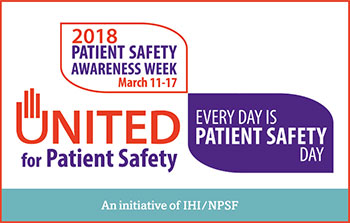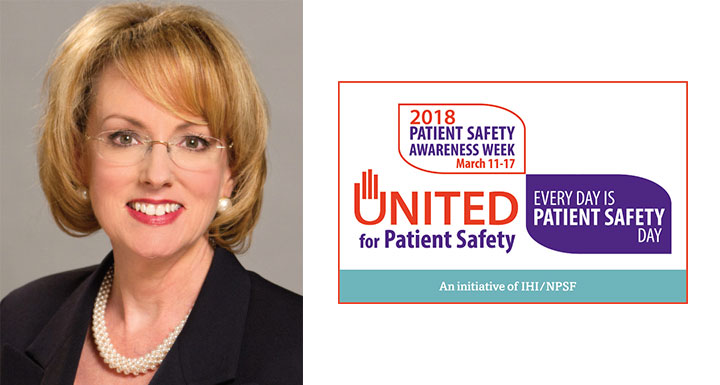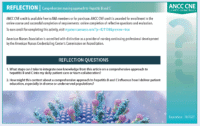Shining a light on a public health crisis
Each year, an important event is nationally recognized but frequently overshadowed by our busy lives: Patient Safety Awareness Week. Seven days are devoted to increase awareness about patient safety in the eyes of all healthcare professionals and the public. This year, patient safety week is March 11-17, 2018, and its importance is critical when you consider that preventable harm in healthcare is a public health crisis; estimates place it as a leading cause of death in the United States.


Maybe it’s because as a system we haven’t taken full responsibility for the level of harm and our part in causing it. Although patients and families play a critical role in preventing medical errors and reducing harm, the responsibility for safe, effective care lies primarily with the leaders of all types of healthcare organizations and the physicians, clinicians, and staff who deliver the care. Many of the barriers to safe practice, such as lack of access to health records and few easy-to-understand tools and checklists for self-care, are the responsibility of the healthcare system.
Here’s one example: Helping patients and families become more confident and effective in their interactions with all of us who serve as their healthcare providers enhances safe care. Many tools already exist, but the system must train professionals to use them and provide the time to educate patients to become effective partners. But what’s usually the first item cut during budget reductions? You know the answer: education and training expenses. Add to that sad reality trying to deliver patient-centered care in our productivity-driven system. Just how much can we actually educate a patient in a 5- to 10-minute interaction?
So yes, we need a Patient Safety Awareness Week every year to shine a laser beam on this real problem. Yes, I’ll settle for the focus during just 1 week out of 52. But I ask you, shouldn’t we strive to make every day patient safety day?
I encourage all nurses and nursing leaders to partner with their patients and families to develop the best, safest, and most compassionate care possible, and to acknowledge that when we fail to deliver on that goal, we’re responsible for both the result and the solution. We’re the most trusted profession. We have the knowledge, skills, and experience to transform a broken system. And just as important, we have a vision of a better healthcare world and the creativity to get us there. But do we have the will? Do we have the collective desire to shun mediocrity and demand better? The nation will pause for a week in the month of March to think about that very issue. Better care at lower costs. We all deserve nothing less.


Lillee Gelinas, MSN, RN, CPPS, FAAN
Editor-in-Chief
lgelinas@healthcommedia.com
Selected references
Centers for Disease Control and Prevention. National Center for Health Statistics: Leading causes of death. March 17, 2017.
Institute of Medicine Committee on Quality of Health Care in America; Kohn LT, Corrigan JM, Donaldson MS, eds. To Err is Human: Building a Safer Health System. Washington, DC: National Academy Press; 2000.
Makary MA, Daniel M. Medical error—The third leading cause of death in the US. BMJ. 2016;353:i2139.
National Patient Safety Foundation’s Lucian Leape Institute. Safety Is Personal: Partnering with Patients and Families for the Safest Care. 2014.
ant3-Gelinas-208


















1 Comment.
The March issue editorial, “Patient Safety Awareness Week: Shining a light on a Public Health Crisis” highlighted the importance of being acutely aware of patient safety year-round to reduce the preventable complications and deaths. While I agree with a call to collaborate with patients and their families, I found a critical element missing: a call to collaborate with each other.
As nurses, we advocate for our patients and their safety. It is the third provision of the nursing code of ethics. In the article, it is acknowledged that education and training is one of the first items reduced during budget cuts. Nurses must stand together and allow their voices to be heard by hospital administrators as well as legislators about the evidence that reveals the importance of education and training, along with safe staffing, in reducing preventable errors and near misses. The goal is to protect patients from harm.
We need to stop being complicit in allowing budget cuts to pile on more work and less support while providing patient care to patients who need us now more than ever. The article asked if we “have the will?”, but I think this should not be a question as it is our duty. The task may seem daunting, but when we advocate with other nurses, patients, and their families we can be the significant force that improves healthcare by demanding better outcomes, better care at lower costs by a fully educated and trained a nursing workforce.
Giselle Gerardi, MSN, RNC-OB